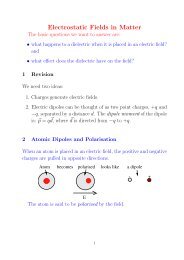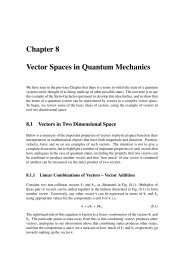set the divergence of Eq. (29) equal to a suitable (electric)<strong>scalar</strong> source charge density ρ e scaled by the free spacepermittivity constant ɛ 0 yield<strong>in</strong>gρ e= ∇ · E = −∇ · ∇φ − ∂∇ · A , (34)ɛ 0 ∂twhere the second term of Eq. (29) vanishes via Eq. (4).Then we set the curl of Eq. (29) equal to a suitable (magnetic)three-<strong>vector</strong> current density j m scaled by the freespace permeability constant µ 0 yield<strong>in</strong>g−µ 0 j m = ∇ × E = −∇ × ∇ × K − ∂∇ × A , (35)∂twhere the first term of Eq. (29) vanishes via Eq. (3).Then we take the partial time derivative of Eq. (29) yield<strong>in</strong>g∂E∂t = −∇∂φ ∂t − ∂∇ × K − ∂2 A∂t ∂t 2 . (36)In contrast to Eqs. (34) <strong>and</strong> (35) it is not evident whatsource density should be equated to the left-h<strong>and</strong> side ofEq. (36). In the present context of a time-vary<strong>in</strong>g electromagnetismwith both electric <strong>and</strong> magnetic charges, sucha third source relation would be <strong>in</strong>consistent because therema<strong>in</strong><strong>in</strong>g two sources, ρ m <strong>and</strong> j e , would need to be accountedfor by the compatible relation (30). In addition,although Eq. (34) is adequate for the time-vary<strong>in</strong>g case,Eq. (35) is adequate only for static <strong>field</strong>s [compare withEq. (11) <strong>in</strong> Ref. 4]. If there are no magnetic sources,j m , ρ m , ξ, <strong>and</strong> K vanish <strong>and</strong> then Eq. (35) also lacks asource to uniquely specify it (or is reduced to no morethan the static case by sett<strong>in</strong>g j m = 0). Equation (30)suffers from similar difficulties with relations analogousto Eqs. (35) <strong>and</strong> (36). Consequently, it is problematicfor there to be a time-dependent version of theorem U1based on Eqs. (29) <strong>and</strong> (30) [or Eq. (26)] for the mostgeneral electromagnetic case.IV. TIME-DEPENDENT THREE-VECTORAND SCALAR FIELD IDENTITIESIn Sec. III it was shown that the use of the timedependentgeneralization (26) of the (static) Helmholtzidentity (13) does not appear to be adequate to obta<strong>in</strong>time-dependent versions of <strong>uniqueness</strong> <strong>theorems</strong> U1 orH1. However, an “extended curl” 5 approach for obta<strong>in</strong><strong>in</strong>ga <strong>uniqueness</strong> theorem for a pair of coupled timedependentthree-<strong>vector</strong> <strong>field</strong>s <strong>in</strong> terms of two <strong>scalar</strong> <strong>and</strong>two three-<strong>vector</strong> source <strong>field</strong>s, <strong>and</strong> <strong>in</strong> terms of two auxiliary<strong>field</strong> def<strong>in</strong>itions such as Eqs. (29) <strong>and</strong> (30), wasformulated <strong>in</strong> Ref. 22. This latter theorem was referredto there as a generalized Helmholtz theorem. 22 From ourpo<strong>in</strong>t of view the first part of this two part theorem is oftype U1, <strong>and</strong> the second part is of the Helmholtz (projection)type H1, although the concepts of irrotational<strong>and</strong> solenoidal are omitted. The proof is based on theexistence of nontrivial solutions of the associated ellipticalor hyperbolic differential equations. In the hyperboliccase the <strong>field</strong> equations can be used to treat the electromagneticcase with both electric <strong>and</strong> magnetic charges.As <strong>in</strong>terest<strong>in</strong>g as this theorem is, its equations are notderived from first pr<strong>in</strong>ciples, but are postulated <strong>in</strong> theirentirety. Secondly, it is a theorem for three-<strong>vector</strong>s <strong>in</strong> R 3with the time-dependence put <strong>in</strong> by h<strong>and</strong>, that is, it is notmanifestly covariant. It will be shown here that a manifestlycovariant approach 6 <strong>in</strong> R 3+1 can yield the desiredtime-vary<strong>in</strong>g <strong>uniqueness</strong> <strong>theorems</strong> that do not appear tofollow from first pr<strong>in</strong>ciples <strong>in</strong> R 3 .It has been previously shown (by tak<strong>in</strong>g a static Newtonianlimit) that the spatial components of the identityEq. (69) of theorem II of Ref. 6 [see Eq. (37)] is a M<strong>in</strong>kowskispace generalization of the (Euclidean three-space)Helmholtz identity (13), but more generally <strong>in</strong> a f<strong>in</strong>itevolume of R 3 . In addition, the fourth or <strong>scalar</strong> <strong>field</strong> componentof this identity [see (Eq. 45)] was shown to yield a<strong>scalar</strong> <strong>field</strong> identity, Eq. (96) of Ref. 6, <strong>in</strong> a similar staticNewtonian limit. To obta<strong>in</strong> the full time-dependent resultswe first take the space components of this identity(that is, where the four-space <strong>in</strong>dex µ is replaced by thethree-space <strong>in</strong>dex j):[ ∫A j (x) = −∂ j ∂ νA ′ ν (x ′ )G(x, x ′ )d 4 x ′V 4′](A∮Σ ν (x ′ )n ′ ν)G(x, x ′ )dΣ ′′−[ ∫− ∂ α (∂ ′α A j (x ′ ) − ∂ ′j A α (x ′ ))G(x, x ′ )d 4 x ′V 4′]+ (A∮Σ α (x ′ )n ′j − A j (x ′ )n ′α )G(x, x ′ )dΣ ′ , (37)′where the four-volume region V 4 ′ of M<strong>in</strong>kowski space-timeis bounded by the three-surface Σ ′ , <strong>and</strong> the unprimedderivatives have been factored out of the primed coord<strong>in</strong>ate<strong>in</strong>tegrals. If we adopt three-<strong>vector</strong> notation <strong>and</strong>allow the four-volume region V 4 ′ to exp<strong>and</strong> to <strong>in</strong>cludeall M<strong>in</strong>kowski space-time so that the three-surface <strong>in</strong>tegralscan be dropped [under the assumption that thefour-<strong>vector</strong> <strong>field</strong> A µ (x) = (φ/c, A) vanishes sufficientlyrapidly at <strong>in</strong>f<strong>in</strong>ity], we can simplify Eq. (37) to∫A(x) = −∇− 1 ∫∂c ∂t∫+ ∇ ×V 4′V 4′V ′4(∇ ′ · A(x ′ ) + 1 ∂φ(x ′ ))c 2 ∂t ′(− 1 ∂A(x ′ )c ∂t ′ − ∇′ φ(x ′ )cG(x, x ′ )d 4 x ′)G(x, x ′ )d 4 x ′(∇ ′ × A(x ′ ))G(x, x ′ )d 4 x ′ , (38)where the first four-volume <strong>in</strong>tegral of Eq. (38) followsfrom the first four-volume <strong>in</strong>tegral of Eq. (37), the secondfour-volume <strong>in</strong>tegral of Eq. (38) follows from the α = 06
component of the second four-volume <strong>in</strong>tegral of Eq. (37),<strong>and</strong> the third four-volume <strong>in</strong>tegral of Eq. (38) followsfrom that same term’s α = i spatial components by compar<strong>in</strong>gthe implied sum on i for each of the j = 1, 2, 3components with the components of the <strong>vector</strong> triplecross product <strong>in</strong> Eq. (38). If we make the change of variables[us<strong>in</strong>g the components of the four-curl of A µ , thatis, Maxwell’s <strong>field</strong> tensor F µν , see Eqs. (55) <strong>and</strong> (56)]withE = −∇φ − ∂A , B = ∇ × A, (39)∂t<strong>and</strong> the change of variables [us<strong>in</strong>g the four-divergence ofA µ , see Eq. (57)] withwe can reduce Eq. (38) to∫A(x) = − ∇C = ∇ · A + 1 c 2 ∂φ∂t , (40)V 4′− 1 ∫∂c 2 ∂t∫+ ∇ ×C(x ′ )G(x, x ′ )d 4 x ′V ′4V ′4E(x ′ )G(x, x ′ )d 4 x ′B(x ′ )G(x, x ′ )d 4 x ′ . (41)We can move the unprimed ∇ operator <strong>in</strong>to the first(primed) <strong>in</strong>tegral of Eq. (41), <strong>and</strong> then as for Eq. (25),we can express the argument of the <strong>in</strong>tegral as∇(C(x ′ )G(x, x ′ )) = −C(x ′ )∇ ′ G(x, x ′ )(42a)= −∇ ′ (C(x ′ )G(x, x ′ )) + (∇ ′ C(x ′ ))G(x, x ′ ), (42b)because the unprimed gradient of C(x ′ ) is zero <strong>and</strong> theGreen’s function property (22a) is used <strong>in</strong> Eq. (42a).Note that∫V ′ ∇ ′ (C(x ′ )G(x, x ′ ))dV ′ = 0 (43)over the <strong>in</strong>f<strong>in</strong>ite three-volume V ′ for the <strong>scalar</strong> <strong>field</strong>C(x ′ ), which is assumed to vanish sufficiently rapidlyat <strong>in</strong>f<strong>in</strong>ity because A <strong>and</strong> φ are assumed to do so also.Therefore, only the second term of Eq. (42b) contributesto Eq. (41). If we use the result (25b) on the second <strong>in</strong>tegralof Eq. (41), assume that E is bounded <strong>in</strong> time, <strong>and</strong>use Eq. (10b) <strong>and</strong> the surface <strong>in</strong>tegral argument that ledto Eq. (13) on the third <strong>in</strong>tegral of Eq. (41), we obta<strong>in</strong>the desired three-<strong>vector</strong> <strong>field</strong> identity∫A(x) =V ′4(−∇ ′ C(x ′ ) − 1 ∂E(x ′ )c 2 ∂t ′)+ ∇ ′ × B(x ′ ) G(x, x ′ )d 4 x ′ . (44)In a similar fashion a <strong>scalar</strong> component of the identityEq. (69) of Ref. 6 can be obta<strong>in</strong>ed as follows:[ ∫A 0 (x) = − ∂ 0 ∂ νA ′ ν (x ′ )G(x, x ′ )d 4 x ′V 4′](A∮Σ ν (x ′ )n ′ ν)G(x, x ′ )dΣ ′′−[ ∫(− ∂ α ∂ ′α A 0 (x ′ ) − ∂ ′ 0 A α (x ′ ) ) G(x, x ′ )d 4 x ′V 4′]+ (A∮Σ α (x ′ )n ′ 0 − A 0 (x ′ )n ′α )G(x, x ′ )dΣ ′ .′(45)We adopt three-<strong>vector</strong> notation, allow the four-volumeV 4 ′ to exp<strong>and</strong> to <strong>in</strong>clude all M<strong>in</strong>kowski space-time, <strong>and</strong>set A 0 = (φ/c) so that Eq. (45) simplifies toφ(x)c∫∂∂t= 1 c∫− ∇ ·V 4′(∇ ′ · A(x ′ ) + 1 ∂φ(x ′ ))c 2 ∂t ′V ′4( ∇ ′ φ(x ′ )+ 1 c cG(x, x ′ )d 4 x ′∂A(x ′ ))∂t ′ G(x, x ′ )d 4 x ′ .(46)The same change of variables, Eqs. (39) <strong>and</strong> (40), reducesEq. (46) toφ(x)c= 1 ∫∂C(x ′ )G(x, x ′ )d 4 x ′c ∂t V 4′+ 1 ·∫c ∇ E(x ′ )G(x, x ′ )d 4 x ′ . (47)V ′4We can move the unprimed ∂/∂t operator <strong>in</strong>to thefirst (primed) <strong>in</strong>tegral of Eq. (47), <strong>and</strong> then, similar toEq. (25), we can express the <strong>in</strong>tegr<strong>and</strong> as:∂(C(x ′ )G(x, x ′ ))∂t= − C(x ′ ) ∂G(x, x′ )∂t ′(48a)= − ∂(C(x′ )G(x, x ′ ))∂t ′ + ∂C(x′ )∂t ′ G(x, x ′ ), (48b)because the unprimed time derivative of C(x ′ ) is zero;<strong>and</strong> the Green’s function property (22b) was used <strong>in</strong>Eq. (48a). A time <strong>in</strong>tegration of the first term ofEq. (48b) can be assumed to vanish as t ′ → ±∞ for the<strong>field</strong> C, which is assumed to be bounded <strong>in</strong> time becauseA <strong>and</strong> φ are assumed to do so also. Therefore, only thesecond term of Eq. (48b) contributes to Eq. (47). We useEq. (10a) <strong>and</strong> the surface <strong>in</strong>tegral argument which led toEq. (13) on the second <strong>in</strong>tegral of Eq. (47) to obta<strong>in</strong> thedesired <strong>scalar</strong> <strong>field</strong> identityφ(x)c= 1 c∫V ′4( ∂C(x ′ ))∂t ′ + ∇ ′ · E(x ′ ) G(x, x ′ )d 4 x ′ .(49)7
















